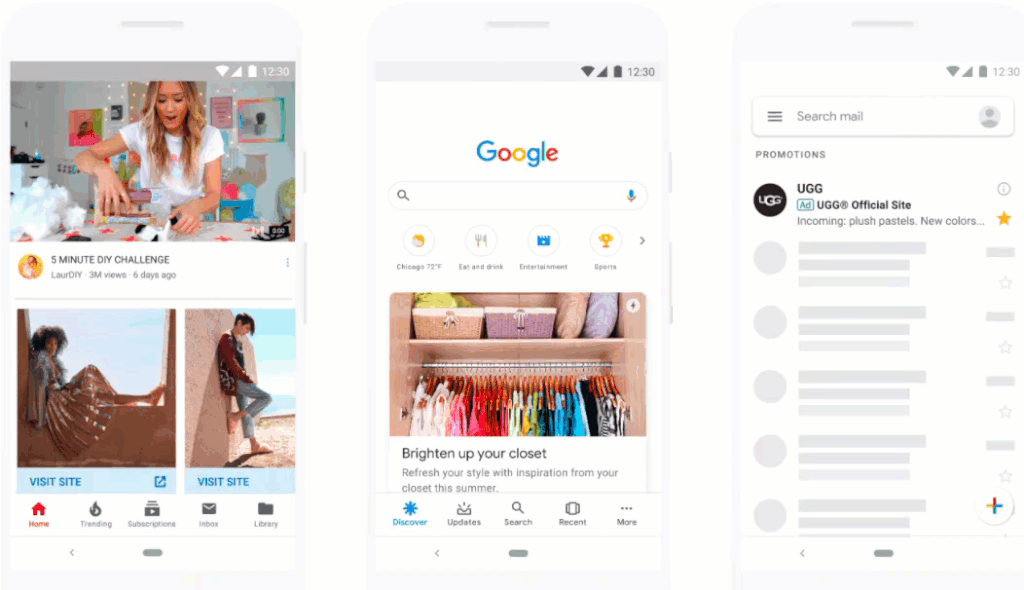Within the Google Ads platform, there are numerous goals, campaign types, and ad formats to choose from. If you’re new to the ecosystem and. trying to determine the best ad strategy for your company, it may be difficult to see how all of these pieces fit together.
Here, we’ll help you determine which types of Google ads are the right fit for your business.
Before we begin, let’s know these terms:
- Campaign goal: The high-level business goal you’re attempting to achieve through Google ads. Sales, leads, web traffic, brand awareness, product/brand consideration, and app promotion are all campaign objectives.
- Campaign type: The specific strategy you’ll use to carry out your campaign goal. For example, you could run a Shopping campaign to boost sales for your eCommerce business. If you want to generate B2B leads, you could run a Search campaign that targets profitable industry keywords (e.g., SEO agency Melbourne).
- Ad type: A specific ad format that is available based on your chosen campaign type and goal. In a Shopping campaign, you could test various ad types (for example, text ads, responsive display ads, or product ads) to see which format generates the most profitable ROI.
In the end, the campaign goal is your business objective. The strategy is the campaign type. Ad formats are the individual tactics (ad units) that will be used to carry out that strategy.
An overview of all Google ads campaigns
Google ads are typically displayed in two locations:
- Google Search Network (GSN): The primary ad network. Advertisers compete for ad placements in Google’s search engine results pages by bidding on search terms. A Search ad is similar to a sponsored ad at the top of Google. In the following section, we’ll go over the various formats.
- Google Display Network (GDN): Display ads are distinct from Google search results. They are visual rather than text-based, and they can be found on other Google properties such as YouTube and Gmail, as well as non-Google websites all over the internet. You know those annoying banner ads that appear at the top of most websites? Those are Google Display advertisements. There are several varieties, which we will discuss shortly.
Here are all campaign types and where they appear:
- Search: Text ads on the Search Engine Result Pages
- Display: Media-rich ads on websites
- Video: Video ads on YouTube
- Shopping: Product ads on Google
- App: Mobile app-specific ads across multiple channels
- Performance Max: An AI-driven, all-in-one campaign builder
- Discovery: Image ads across Google’s feed placements
As we stated in the introduction, the campaign type you select is determined by your marketing objective. Here are a few examples:
- Lead generation
- Sales
- Website Traffic
- App Promotion
Once you’ve decided on a goal and campaign type, you can focus on the specific types of Google ads that will help you achieve your goal.
Let’s take a look at each.
- Search Ads
Search ads are text ads that appear on SERPs. For example, a search for “sports shoes” yields the following results.

The advantage of search ads is that your ad will appear where most searchers look for information first — on Google. Furthermore, Google displays your ad in the same format as other results (except that it is labelled as an “Ad”), so users are used to seeing and clicking on results.
Responsive Search Ads
Responsive search ads allow you to enter 15 headlines and 4 ad copy variations, from which Google will select the best performers to display to users.
Responsive ads enable a dynamic ad that is auto-tested until you reach the version that is best suited for your target audience — for Google, this means until you get the most clicks.
Call-Only Ads
This ad type is appropriate if your company generates leads or sales through phone calls.
When a user clicks a call ad on mobile, the ad places a call directly to you from the SERP. It is then up to you to convert those calls.

Dynamic Search Ads
Dynamic Search ads are similar to Responsive Search ads in that Google pulls content directly from your website rather than using assets you provide (e.g., headlines, copy, etc.).
When someone searches for your product or service, Google Ads will generate a dynamic ad with a clear headline for the most relevant page on your site.
- Display Ad Campaigns
Display ads are banners, images, and video ads that appear across the Google Display Network’s websites, videos, and apps.

As you can see, Display ads are far more visually appealing than Search ads. They are also more prevalent in various types of content.
The truth is that most people ignore Display ads or regard them as annoying clickbait. Display ads are intentionally intrusive. As a result, it’s not surprising that the click-through rate across all industries is abysmal—less than 1%.
CTR, on the other hand, does not fully represent the impact of display ads. While most people will not click on them, some will Google your product and visit your website later. They may even buy without ever clicking your ad, which is known as a view-through conversion.
- Video Ads Campaigns
Video ads appear before, after, or in the middle of YouTube videos. Remember that YouTube is also a search engine. The right keywords will put you in front of a video, disrupting the user’s behaviour just enough to get their attention.

YouTube ads are ideal because of their visual format and targeting options
- Remarketing
- Brand Awareness
- Marketing products aesthetically
YouTube ad campaigns can be extremely profitable, but only if you can create compelling video advertisements.
- Shopping Campaign
Shopping campaigns promote products to pre-purchase audiences. Shopping campaigns, like the others, appear on SERPs and include detailed product descriptions such as price and product images.
These are shopping ads:

You can launch a Shopping campaign via Google Merchant Centre, where you can enter specific product information that Google will use to create your shopping ads. When people click on a product in the ad, they are taken directly to the product page on your website.
Shopping campaigns account for the vast majority of our eCommerce clients’ marketing budgets and a substantial portion of their recurring revenue across all channels.
- App Ad Campaigns
App campaigns are automated advertisements that are used to increase mobile app installs and in-app conversions.
You can run ads to entice your audience to download your app or, if they already have it, to perform a specific action within it.
They are also easier to set up.
Google collects information from your app to generate ads in various formats based on the network it will appear on—Google Search and Display, Google Play, YouTube, Discover, and over 3 million sites and apps.
App ads, as seen in the examples below, are quite simple. The logo, headline, description, and CTA are all included. The format may differ slightly depending on the platform, but it is all very similar.

Source: Google Help
- Performance Max
Google generates ads dynamically in Performance Max, testing different combinations across different formats and networks while optimising for the desired action. Your ads will appear in a variety of formats and placements.

Source: Google
Ad placements for Performance Max include YouTube, Display, Search, Discover, Gmail, and Maps.
All you have to do is upload different assets for each placement option—everything Google could possibly require to create unique campaigns for each format (text, video, image, product feed).
Following that, Google employs machine learning to display your ads to people who are most likely to convert.
- Discovery Ads
Discovery campaigns are similar to display ads. They are intended to display visually appealing advertisements using standard audience targeting.
The distinction is between where your ads appear and the formats available to you.
Discovery ads appear across the Google Display Network and are served on a few specific feeds, including YouTube’s Home and Watch Next feeds, Gmail, and Discover in the Google search mobile app.
Discovery ads are designed to show audiences what Google believes they need rather than waiting for them to search for it directly. Google learns user behaviour to predict their interests and serve relevant ads that appear native to the platform on which they appear.
In reality, Discovery ads are hardly any different from Display ads; they simply appear in different places.

Source: Portent
Google Ads, given its reach and authority, should be a part of your paid strategy. Use the suggestions we provided to get started and remember to refine and iterate as you go.
There is no such thing as a failed Google Ads campaign; only those that require a little more attention. Using the information provided above, you may now have an idea of how to use each campaign to your benefit.


